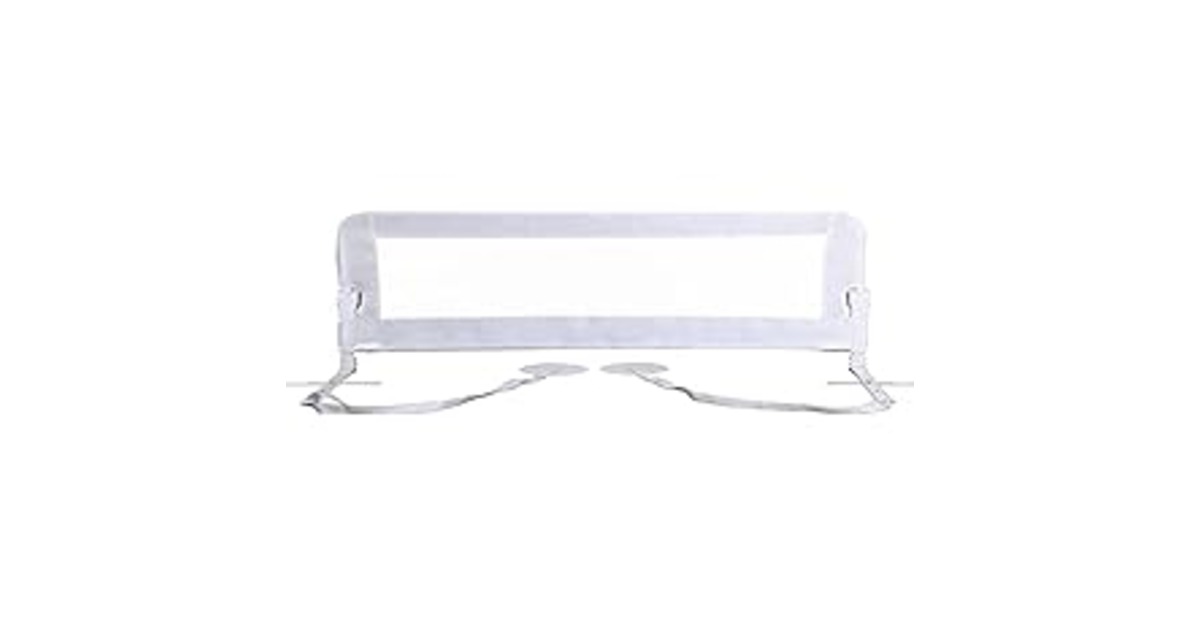Bedtime should be a peaceful and comforting experience for both parents and children. As a parent, nothing is more important than the safety and well-being of your little ones. That’s why choosing the best bed rails for your kids is crucial to ensure their safety and give you peace of mind. Bed rails provide an added layer of protection, preventing your child from rolling off the bed during the night. In this comprehensive guide, we will explore the importance of bed rails, the different types available, factors to consider when choosing one, installation and setup tips, safety guidelines, features to look for, top-rated bed rails on the market, where to buy them, and even alternative options. So let’s dive in and make bedtime a worry-free experience!
The Importance of Bed Rails for Kids’ Safety
Bed rails play a vital role in creating a safe sleep environment for your child. Young children are prone to moving around at night, making them susceptible to falling off the bed. This can result in injuries that range from minor bumps and bruises to more serious accidents. Bed rails act as a barrier, preventing your child from accidentally rolling off the bed and providing a sense of security for both you and your little one.
When transitioning your child from a crib to a bed, it’s crucial to consider their safety. Bed rails offer a practical and effective solution, ensuring your child’s well-being while they sleep. By investing in a quality bed rail, you can have peace of mind knowing that your child is protected throughout the night.
Types of Bed Rails Available
When it comes to choosing bed rails for your kids, you’ll find a wide range of options available on the market. Understanding the different types can help you make an informed decision based on your child’s needs and the bed you have. Here are the most common types of bed rails:
Fixed Bed Rails: These bed rails are permanently attached to the bed frame, providing a sturdy barrier on one or both sides of the bed. They are ideal for children who tend to move around a lot during sleep.
Foldable Bed Rails: As the name suggests, these bed rails can be easily folded down when not in use. They are convenient for parents who want flexibility and easy access to their child’s bed.
Inflatable Bed Rails: These bed rails are inflatable and can be easily transported or stored when not in use. They are great for travel or if you need a temporary solution.
Mesh Bed Rails: Made from breathable mesh material, these bed rails offer a transparent barrier that allows airflow while still providing safety. They are popular for their lightweight design and ease of installation.
Convertible Bed Rails: Convertible bed rails can be adjusted to fit different bed sizes, making them versatile and adaptable as your child grows. They are a cost-effective choice for long-term use.
Consider the specific needs of your child and the bed they will be using when deciding which type of bed rail is best suited for your situation. Each type has its own advantages and considerations.
Factors to Consider When Choosing Bed Rails
To ensure you choose the best bed rails for your kids, there are several important factors to consider. Taking these into account will help you make an informed decision that meets your child’s safety requirements. Here are the key factors to keep in mind:
1. Bed Size and Compatibility
Before purchasing bed rails, it’s crucial to measure the dimensions of your child’s bed. Different bed rails are designed for specific bed sizes, so you need to ensure compatibility. Measure the length and height of the bed, as well as the mattress thickness, to find the right fit.
2. Safety Standards
Ensure that the bed rail you choose meets the required safety standards. Look for certifications from reputable organizations that guarantee the product’s safety and durability. Check for features like secure locking mechanisms, sturdy construction, and non-toxic materials.
3. Ease of Installation and Use
Consider how easy it is to install and use the bed rail. Look for clear instructions and user-friendly designs that make the installation process straightforward. Some bed rails even come with additional features like quick-release mechanisms, making it easier to remove and reattach the rail as needed.
4. Comfort and Accessibility
Your child’s comfort is paramount. Look for bed rails that have a smooth and comfortable surface, with no sharp edges or rough materials that could cause discomfort during sleep. Additionally, consider how accessible the bed rail is for your child to climb in and out of bed independently.
5. Durability and Longevity
Invest in bed rails that are built to last. Look for sturdy materials and solid construction that can withstand the daily wear and tear of an active child. Bed rails with adjustable features that grow with your child can be a cost-effective option, saving you from having to purchase new ones as your child gets older.
By considering these factors, you can narrow down your options and choose the bed rail that best suits your child’s needs and provides the highest level of safety.
Bed Rail Installation and Setup
Once you have chosen the right bed rail for your child, it’s essential to install and set it up correctly to ensure maximum safety. Here are some general guidelines to follow during the installation process:
Read the Instructions: Before starting the installation, carefully read the manufacturer’s instructions provided with the bed rail. Familiarize yourself with the specific requirements and any additional safety precautions.
Inspect the Bed Rail: Thoroughly inspect the bed rail for any defects or damage before installation. Ensure that all parts are present and in good condition.
Positioning: Determine the optimal placement of the bed rail on the bed. Depending on the type of bed rail, you may need to attach it to the mattress, bed frame, or both. Follow the manufacturer’s guidelines for proper positioning.
Secure Attachment: Use the provided straps, screws, or other fastening mechanisms to securely attach the bed rail to the bed. Double-check that the attachment is tight and stable to prevent any movement or dislodging.
Test for Stability: Once the bed rail is installed, test its stability by applying gentle pressure. Ensure that it remains firmly in place and doesn’t wobble or shift when pressure is applied.
Adjustment and Fit: If the bed rail is adjustable, make any necessary adjustments to ensure it fits snugly against the bed. Avoid any gaps between the bed rail and the mattress or bed frame, as they pose a safety risk.
Educate Your Child: Teach your child about the purpose and proper use of the bed rail. Explain that it is there to keep them safe and emphasize the importance of not attempting to climb over or remove it.
By following these installation guidelines, you can ensure that the bed rail is properly set up and provides the necessary protection for your child.
Bed Rail Safety Guidelines
While bed rails are designed to enhance safety, it’s important to follow additional safety guidelines to further reduce the risk of accidents. Here are some essential safety tips to keep in mind:
1. Regular Inspections
Regularly inspect the bed rail for any signs of wear and tear, loose parts, or damage. Check the attachment points and ensure they remain secure. If you notice any issues, repair or replace the bed rail immediately.
2. Height Considerations
Ensure that the bed rail height is appropriate for your child’s age and size. The rail should be high enough to prevent your child from rolling off the bed, but not so high that it hinders their ability to enter and exit the bed independently.
3. Supervision
While bed rails provide an added layer of safety, they do not replace adult supervision. Always supervise your child during bedtime and check on them regularly to ensure they are safe and comfortable.
4. Proper Bed Placement
Position the bed against a wall whenever possible. This will provide an additional barrier on one side, reducing the risk of your child rolling off the bed. If the bed is placed away from the wall, ensure the bed rail is installed on both sides for optimal safety.
5. Age Appropriate
Consider your child’s age and development when deciding whether they still require a bed rail. As they grow older and become more aware of their surroundings, they may no longer need the added protection. Gradually transition them to sleeping without the bed rail when appropriate.
By following these safety guidelines, you can create a secure sleep environment for your child and minimize the risk of accidents.
Features to Look for in the Best Bed Rails
When selecting the best bed rails for your kids, certain features can enhance their effectiveness and usability. Consider the following features when making your decision:
1. Secure Locking Mechanism
Look for bed rails with a secure locking mechanism that ensures the rail remains firmly in place once attached. This will prevent any accidental shifts or movements that could compromise your child’s safety.
2. Breathable Materials
Opt for bed rails made from breathable materials, such as mesh. This allows for proper air circulation, ensuring your child stays cool and comfortable throughout the night.
3. Easy Installation and Removal
Choose bed rails that are easy to install and remove. Look for features like quick-release mechanisms or simple attachment methods that make it convenient for you to adjust or remove the rail as needed.
4. Adjustable Length
If you plan to use the bed rail for an extended period or with different bed sizes, consider an adjustable length feature. This allows you to customize the fit and ensure the bed rail is always the perfect size for your child’s bed.
5. Compact and Portable
If you frequently travel or need a temporary bed rail solution, consider one that is compact and portable. Look for bed rails that can be easily folded or deflated for convenient storage and transportation.
By prioritizing these features, you can find bed rails that offer both practicality and safety for your child.
Reviews of Top-Rated Bed Rails
To help you in your search for the best bed rails, we have compiled a list of top-rated options based on customer reviews and expert recommendations. These bed rails have consistently received positive feedback for their quality, safety, and performance. Here are our top picks:
1. Safety 1st Portable Bed Rail

Safety 1st Portable bed rail is a useful bed accessory for a peaceful night’s sleep, even when travelling: it allows children to sleep safely and prevents them from falling out of bed while they are sleeping.
This bed rail is a portable safety rail that can be folded up and extended for easy transport. It fits standard beds and beds with wooden boards: it fits comfortably under the mattress. It is compatible with mattresses from 156 cm – 190,5 cm long and 10 to 23 cm thick.
The side rail is made of durable yet lightweight material and is fitted with a mesh fabric that allows good ventilation while enabling the parent to monitor the child at all times.
2. Littles Bed Guard Rail
- Little bed Guard measures 83cm L x 48.5cm H. Fits divan, box-spring, recessed, flat and slatted bed bases
- Compatible with mattresses: length >83cm, width > 35cm, thickness Up to 32cm
- 2 Push-button hinge folds down for easy access to the bed or to change linens. Automatic locking in the safety up position
- Soft padded frame for extra safety. Smooth & safe angles. Soft, visible, breathable, washable, strong & durable selective mesh material.
- Lifetime guarantee. Tested and approved by the most recognized institutions worldwide including BSI & SGS. Made in Turkey.

3. BANBALOO | Toddler Bed Guard
BANBALOO Bed Bumper is the ideal transitioning tool for graduating your toddler from crib to bed. If a child gets too close to the edge of the bed the bumper serves as a ‘passive safety’ reminder to return to the center of the bed. Made with High-density memory foam and covered with a non-slip cover and water resistant, this bed rail provides your toddler with a safe night sleep and a clear conscience for you.

These bed rails have proven to be reliable and effective in providing the necessary safety measures for children. Consider these options when making your final decision.
Where to Buy Bed Rails
Now that you have a better understanding of the types of bed rails available and the features to look for, you may be wondering where to purchase them. Here are some popular options:
Local Baby Stores: Visit baby stores in your area that specialize in baby furniture and accessories. They are likely to have a selection of bed rails for you to choose from. You can also seek advice from store staff who can provide recommendations based on your specific needs.
Online Retailers: Online retailers such as Amazon, eBay, and Walmart offer a wide range of bed rails. You can browse through different brands, compare prices, read customer reviews, and have the bed rails conveniently delivered to your doorstep.
Manufacturer’s Websites: Some bed rail manufacturers have their own websites where you can directly purchase their products. This allows you to access detailed information, view product specifications, and potentially benefit from any exclusive offers or promotions.
Second-Hand Options: Consider checking local classified ads, online marketplaces, or parenting groups for second-hand bed rails. Ensure that the bed rail is in good condition and meets safety standards before purchasing.
Remember to compare prices, read reviews, and consider any additional costs such as shipping or return policies when deciding where to buy bed rails.
Bed Rail Alternatives
While bed rails are a popular choice for ensuring your child’s safety, they might not be suitable for every situation. Here are some alternative options that you might consider:
1. Bed Bumpers
Bed bumpers are cushioned barriers that can be placed alongside the bed to prevent your child from rolling off. They are typically made from foam or inflatable materials and can be an effective alternative to traditional bed rails. However, it’s essential to ensure that the bed bumpers are securely attached to the bed and provide adequate protection.
2. Floor Mattresses
For older children who are transitioning to a regular bed, using a floor mattress can provide a safe and comfortable sleep environment. By placing the mattress directly on the floor, the risk of falling off the bed is eliminated. However, it’s important to ensure that the mattress is of a suitable height and provides adequate support for your child’s needs.
3. Bed Tents
Bed tents are another alternative that can provide a cosy and enclosed sleeping space for your child. They fit over the bed, creating a protective canopy that prevents your child from rolling out. Bed tents are handy for children who need a sense of security or have difficulty staying in bed.
Consider these alternatives if bed rails are not the best fit for your child’s specific needs or if you prefer to explore other options.
Conclusion
Choosing the best bed rails for your kids is a crucial step in ensuring their safety and peace of mind during bedtime. Bed rails provide an added layer of protection, preventing your child from rolling off the bed and reducing the risk of injuries. By considering the different types of bed rails available, factors to consider when choosing one, installation and setup tips, safety guidelines, and features to look for, you can make an informed decision that meets your child’s needs. Additionally, exploring top-rated bed rails and alternative options can help you find the perfect solution for your family. So invest in quality bed rails and create a secure sleep environment that promotes safety and comfort for your little ones.
Remember, a good night’s sleep for your child means a good night’s sleep for you too!






















One response to “Ensuring Safety and Peace of Mind: A Guide to Choosing the Best Bed Rails for Your Kids”
[…] Safety should be a top priority when using a baby changing table. Always ensure that your baby is within arm’s reach and never leave them unattended, even for a moment. Keep all supplies within easy reach, but out of your baby’s reach to prevent any accidents or choking hazards. […]